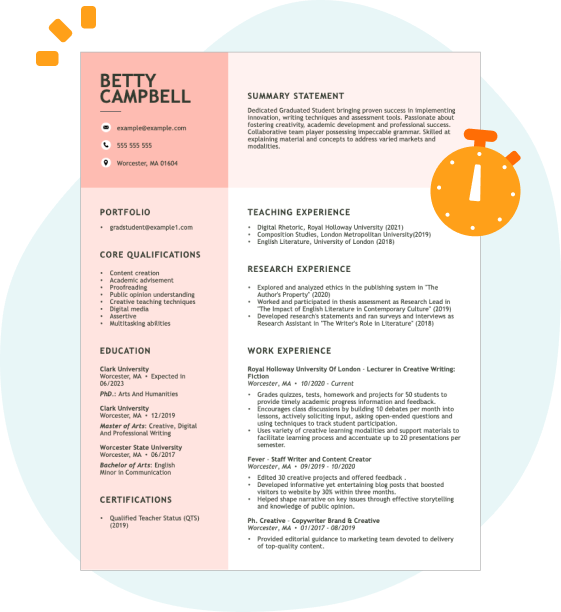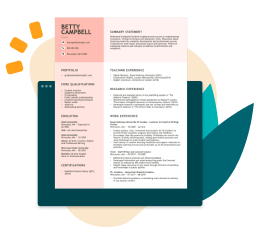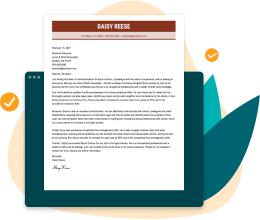Hard skills are technical abilities such as operating machinery, understanding production processes, and ensuring quality control standards.
Popular Production Operator Resume Examples
Check out our top production operator resume examples that emphasize key skills such as machinery operation, quality control, and teamwork. These examples can help you effectively demonstrate your qualifications to potential employers.
Ready to build your ideal resume? Our Resume Builder offers straightforward templates designed specifically for production professionals, making it simple to create a standout application.
Entry-level production operator resume
This entry-level resume for a production operator effectively showcases the job seeker's hands-on experience with machinery operation and a strong commitment to safety, evidenced by their compliance records and efficiency improvements. New professionals in this field must demonstrate their ability to optimize production processes and adhere to safety standards, even with limited work history.
Mid-career production operator resume
This resume effectively showcases the applicant's qualifications by emphasizing achievements in process improvement and team leadership. The structured presentation highlights readiness for advanced roles, indicating a strong progression in responsibility and operational excellence within the manufacturing sector.
Experienced production operator resume
The applicant's work experience section highlights their expertise in efficiency and productivity, with achievements like reducing waste by 15% and training staff to boost productivity by 20%. The clear formatting aids quick comprehension for hiring managers.
Resume Template—Easy to Copy & Paste
John Johnson
Jacksonville, FL 32206
(555)555-5555
John.Johnson@example.com
Professional Summary
Dynamic Production Operator skilled in optimizing processes, leading teams, and enhancing quality with proven success in reducing costs and improving output efficiency.
Work History
Production Operator
ProMotive Manufacturing Co. - Jacksonville, FL
January 2023 - December 2025
- Improved efficiency by 15% annually.
- Led team reducing waste by 8%.
- Cut downtime costs by 10k.
Assembly Technician
Precision Parts Inc. - Tampa, FL
January 2020 - December 2022
- Trained staff, boosting output 20%.
- Managed inventory, saving k monthly.
- Enhanced quality assurance by 10%.
Machinery Operator
Engineered Solutions LLC - Riverview, FL
January 2019 - December 2019
- Achieved 95% accuracy in tasks.
- Reduced setup time by 20%.
- Streamlined processes increasing output.
Skills
- Process Optimization
- Team Leadership
- Quality Assurance
- Inventory Management
- Lean Manufacturing
- Safety Compliance
- Machinery Operations
- Technical Troubleshooting
Certifications
- Certified Production Technician - Manufacturing Skill Standards Council
- Lean Six Sigma Green Belt - Institute of Industrial Engineers
Education
Master of Science Manufacturing Engineering
Indiana State University Terre Haute, Indiana
May 2019
Bachelor of Science Industrial Engineering
Purdue University West Lafayette, Indiana
May 2017
Languages
- Spanish - Beginner (A1)
- German - Intermediate (B1)
- French - Beginner (A1)
How to Write a Production Operator Resume Summary
Your resume summary is the first thing employers see, making it important for creating a positive impression. As a production operator, you should highlight your technical skills and attention to detail, which are essential in ensuring efficient operations.
Emphasizing your experience with machinery and quality control will set you apart from other applicants. This section should succinctly reflect your qualifications and readiness for the role you're targeting.
To help you understand effective strategies, here are some production operator resume summary examples that illustrate what works well and what to avoid:
Weak resume summary
I am an experienced production operator with a history of working in manufacturing. I am seeking a position where I can apply my skills and grow within the company. A supportive environment that encourages learning and development would be ideal. I am eager to contribute positively if given the chance.
- Lacks specific details about the applicant's skills or achievements, making it too generic
- Focuses more on what the applicant desires from a job rather than what they can contribute
- Uses personal language that doesn't highlight unique qualifications relevant to a production operator role
Strong resume summary
Results-driven production operator with over 6 years of experience in high-volume manufacturing environments. Achieved a 20% increase in production efficiency by implementing lean manufacturing techniques and streamlining workflows. Proficient in operating advanced machinery, quality control processes, and adhering to safety regulations to ensure optimal production output.
- Begins with clear experience level and industry relevance
- Highlights a quantifiable achievement that showcases the applicant's impact on productivity
- Demonstrates specific technical skills essential for the production operator role
PRO TIP
Showcasing Your Work Experience
The work experience section is the cornerstone of your resume as a production operator. This is where you’ll find most of your content, and effective resume templates always prioritize this section.
Organize this part chronologically, listing your previous positions in reverse order. Use bullet points to highlight key achievements and responsibilities in each role for clarity.
To further assist you, we have prepared a couple of examples that illustrate what makes a powerful work history entry for production operators. These examples will show you what works well and what should be avoided:
Production Operator
ABC Manufacturing – Detroit, MI
- Operated machinery on the production line.
- Followed safety protocols and maintained a clean workspace.
- Collaborated with team members to meet daily targets.
- Reported quality issues to supervisors.
- Lacks specific employment dates for context
- Bullet points are overly simplistic and do not highlight unique skills or accomplishments
- Emphasizes routine tasks rather than showcasing strong contributions or improvements
Production Operator
XYZ Manufacturing Inc. – Chicago, IL
March 2020 - Current
- Operate and monitor production machinery to ensure efficient workflow, achieving a 15% increase in output quality during the first year.
- Conduct regular quality checks and troubleshoot equipment issues, reducing downtime by 20% through proactive maintenance efforts.
- Train new operators on safety protocols and operational procedures, improving team compliance with safety standards by 30%.
- Uses action verbs to clearly illustrate the job seeker's contributions
- Incorporates specific metrics to quantify achievements, demonstrating impact effectively
- Highlights relevant skills such as teamwork, troubleshooting, and training which are important for the role
While your resume summary and work experience often take center stage, it’s essential to give equal consideration to other sections. These parts are critical for showcasing your skills and qualifications. To gain expert guidance on crafting a complete resume, be sure to explore our detailed guide on how to write a resume.
Top Skills to Include on Your Resume
A well-defined skills section is important for a production operator's resume. It allows you to showcase your qualifications and demonstrate that you possess the necessary abilities for the role.
Add both hard and soft skills to create a well-rounded resume.
On the other hand, soft skills like attention to detail, teamwork, and effective communication are essential for maintaining a safe work environment and fostering collaboration among team members.
Selecting the right resume skills is important for standing out to employers. Many organizations use automated systems to screen job seekers, making it essential to align your skills with what they seek.
To effectively tailor your resume, closely examine job postings for specific skill requirements. This will help you highlight the most relevant abilities that appeal to both recruiters and ATS technology, increasing your chances of being noticed.
PRO TIP
10 skills that appear on successful production operator resumes
Highlighting essential skills in your resume can significantly increase your chances of catching a recruiter's eye for production operator roles. You can see these skills effectively showcased in our resume examples, which provide the confidence needed to apply for jobs successfully.
Here are 10 skills you should consider including in your resume if they fit your qualifications and role requirements:
Attention to detail
Mechanical aptitude
Problem-solving abilities
Team collaboration
Time management
Quality control knowledge
Safety compliance awareness
Equipment operation skill
Adaptability to change
Basic math skills
Based on analysis of 5,000+ production professional resumes from 2023-2024
Resume Format Examples
Selecting the correct resume format is important for production operators because it highlights your relevant skills, experience, and career growth in a clear and compelling way.
Functional
Focuses on skills rather than previous jobs
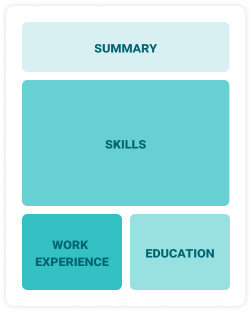
Best for:
Recent graduates and career changers with up to two years of experience
Combination
Balances skills and work history equally
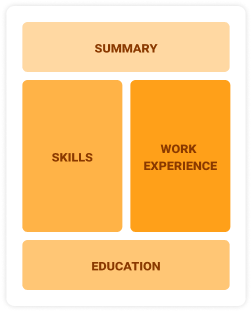
Best for:
Mid-career professionals focused on demonstrating skills and pursuing growth opportunities
Chronological
Emphasizes work history in reverse order
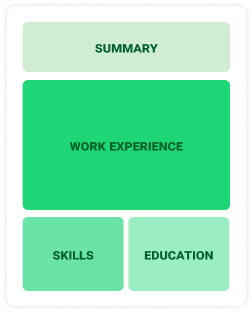
Best for:
Seasoned operators excelling in process improvement and team leadership
Frequently Asked Questions
Should I include a cover letter with my production operator resume?
Absolutely, including a cover letter can significantly improve your application by showcasing your personality and detailing your relevant skills. It allows you to connect your experience directly to the job. For assistance, explore our comprehensive guide on how to write a cover letter or use our easy-to-use Cover Letter Generator to create one quickly.
Can I use a resume if I’m applying internationally, or do I need a CV?
When applying for jobs in many countries, a CV is often preferred over a resume. It's essential to adapt your application to local norms. Explore our CV examples and discover how to write a CV with proper formatting and effective writing tips tailored for international job seekers.
What soft skills are important for production operators?
Soft skills such as communication, teamwork, and problem-solving are essential for production operators. These interpersonal skills foster collaboration among team members, improve safety protocols, and improve the efficiency of operations, ultimately leading to a more productive work environment.
I’m transitioning from another field. How should I highlight my experience?
Highlight your transferable skills such as teamwork, attention to detail, and adaptability when applying for production operator roles. These qualities illustrate your capacity to excel despite limited experience in the field. Share specific instances from previous jobs that showcase how you tackled challenges or improved processes, linking those achievements to the demands of a production environment.
Where can I find inspiration for writing my cover letter as a production operator?
For those seeking production operator roles, exploring professional cover letter examples can be incredibly beneficial. These samples provide valuable insights into effective formatting and content ideas, helping you showcase your skills and experience in a compelling manner. Use them as a guide to create your own standout application materials.
Should I use a cover letter template?
Yes, using a cover letter template for production operators is advisable as it provides a clear structure, organizes content efficiently, and helps you highlight relevant skills such as machinery operation and quality control experience, making your application stand out to hiring managers.


